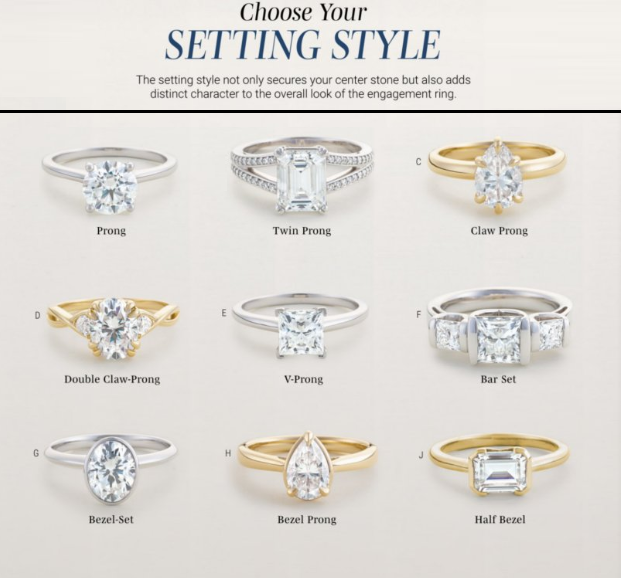Choosing a center stone gets most of the attention, but the setting is what gives an engagement rings its personality, presence, and day-to-day wearability. It changes how the diamond or gemstone looks, how it catches light, and how it feels on the hand. It also influences budget, care, and long-term comfort. We’ve helped couples in Greenville since 1988 pick settings that fit their lives, so consider this your friendly field guide to the styles you’ll see when you sit down with us for a design consult.
We’ll cover the classics, the quiet performers, the showstoppers, and the intricate beauties. You’ll find quick comparisons, real-life examples, and pointers on matching settings to shapes and lifestyles. And when you’re ready, we can build free photo-realistic images of your favorite ideas, with access to millions of diamonds and thousands of settings.
What a setting actually does
A ring setting is the structure that holds your stone and shapes the overall style. Its job is part theater, part engineering.
- Presentation: frames the center gem and sets the mood, from sleek minimalist to ornate heirloom.
- Light: controls how much light reaches the diamond. More exposure typically means more fire and brilliance.
- Security: protects edges and tips, keeps stones firmly in place.
- Comfort: determines profile height, snag risk, and how the ring pairs with a wedding band.
- Cost: adds or reduces labor and materials depending on complexity and number of accent stones.
Think of it as the stage, spotlight, and safety harness for your gem.
The classics most people start with
Solitaire
A single center stone on a clean band is the standard for a reason. Prongs lift the diamond just enough to catch light, creating near-max sparkle without any competition from other stones. Four prongs feel open and airy. Six prongs give a round shape a slightly fuller outline and extra security.
Variations keep a solitaire interesting. A cathedral profile arcs the shoulders up toward the stone for graceful lines. A knife-edge band angles the top of the shank for crisp detail. A bezel solitaire trades prongs for a slim rim of metal, adding peace of mind.
Why you might pick it:
- Timeless, goes with any wedding band
- Focuses every bit of attention on the center
- Offers the most stone for the money in many cases
We regularly remake classic solitaires for clients who want a larger upgrade later, and we can do that cleanly because the design keeps the spotlight on the gem.
Halo
A halo wraps the center stone in a ring of smaller diamonds. It looks “bigger” at a glance and glows from the extra facets in tiny stones. Single halos are the most common. Double halos deliver a high-contrast frame with serious sparkle. Hidden halos tuck a delicate ring of diamonds beneath the center, so you catch shimmer from the side.
Why it stands out:
- Makes a smaller center appear larger
- Adds texture and light from all angles
- Offers lots of room for personal touches, like colored gemstone accents
Our Cherie KI-115182-W is a favorite for a soft, romantic halo with an elegant profile that still fits beautifully with a wedding band.
Three-stone
A center stone flanked by two side stones gives balance and presence. Many couples like the meaning: past, present, future. Side stones can match the center shape or create contrast, like a round center with tapered baguettes or a pear on each side of an oval.
Why clients love it:
- More total sparkle without going oversize on the center
- A chance to include birthstones or colored gems
- Extra width across the finger, which many find flattering
We often design three-stone rings that keep a low profile, so the look is grand but the ring stays comfortable for daily wear.
Pavé
Pavé means the band is set with tiny diamonds that sit close together. The result looks like the band is paved with light. Micro-pavé uses very small stones for a fine, continuous shimmer. French pavé features tiny beads and cutouts for texture.
What to know:
- Huge sparkle per millimeter of metal
- Gorgeous next to a solitaire or in a halo
- Needs occasional inspection, since there are many small prongs
We offer pavé in classic straight shanks, delicate knife-edge shanks, and our 3 ct pavé bracelets for stacked looks beyond the ring itself.
Secure and smooth designs
Bezel
A bezel holds the stone in a thin rim of metal. Full bezels surround the gem completely. Half bezels cover the sides while leaving some of the girdle exposed. Either way, bezels deliver the most protection for edges and tips, and they slide cleanly under gloves and sleeves.
Why it’s a smart pick:
- Low snag risk, great for active hands
- Protects delicate shapes and softer gems
- Sleek, modern lines or old-world charm with milgrain and engraving
We often pair a round or oval in a bezel with a simple channel-set band for clients in healthcare or people who prefer a low-profile ring that still looks refined.
Channel
Channel-set side stones sit between two walls of metal for a smooth finish. This style is common in wedding bands and as accents on engagement rings. It looks streamlined and is tough against daily bumps.
Highlights:
- No prongs on the band to catch on sweaters
- Built-in protection for small diamonds or baguettes
- Works well as half channel on top for light, or full channel all the way around
Tension and tension-style
True tension settings hold the stone by pressure between the ends of the band, which makes the gem appear to float. Tension settings require special manufacturing methods that give the metal the strength needed to hold the diamond with minimal support. This is not a standard offering at Sabyl’s, but if you want a tension setting, let us know and we will look into making it.
Instead, please consider what we call “tension-style” rings.
Many rings you see are tension-style, meaning hidden supports help secure the stone while keeping the floating look.
Good to know:
- Dramatic presentation with lots of exposed facets
- Requires precise engineering and usually hard stones like diamond or Moissanite
- Not the easiest style to resize
We can design tension-style rings that mix modern drama with hidden security if you love the look but want extra peace of mind.
Cluster and vintage-inspired styles
Cluster
Instead of one big stone, many smaller stones are grouped to create a larger shape: a flower, a starburst, a geometric square. The effect can mimic a single center or lean into intricate patterns.
Reasons to consider it:
- Big look at a friendlier price than one large diamond of the same total weight
- A lot of creative freedom with shapes and cut mixes
- Often reads as vintage, especially with milgrain and engraving
Vintage-inspired
Victorian filigree, Edwardian lace-like details, or bold Art Deco geometry can be built into almost any setting. A simple solitaire becomes romantic with hand engraving. A halo gets an antique feel with scalloped edges and milgrain. Emerald cuts and step cuts are standouts in Deco designs with baguettes.
We’ve created custom Art Deco remounts and emerald-cut rings that echo heirloom pieces while using modern craftsmanship. If you have a family stone, this is a beautiful route.
A quick side-by-side look
| Setting | Look | Sparkle | Care level | Great for |
|---|---|---|---|---|
| Solitaire | Clean, classic, center stage | Very high | Low to moderate, prongs need periodic checks | Timeless taste, easy wedding band pairing |
| Halo | Framed, larger visual size | Very high | Moderate, many tiny prongs | Extra presence, vintage or glam style |
| Three-stone | Balanced, bold width | High | Moderate, multiple stones | Symbolism, color accents, finger coverage |
| Pavé band | Band glitters too | Very high | Moderate to high | Delicate shimmer, detail lovers |
| Bezel | Smooth, secure | Good | Low, easy to clean | Active lifestyles, delicate stone shapes |
| Channel | Streamlined, flush | Good | Low | Snag-free bands, baguette accents |
| Tension-style | Floating stone, modern | Very high | Moderate, precise sizing | Standout contemporary look |
| Cluster | Intricate, unique | High overall | High, many details | Big look, vintage flavor |
Matching a setting to the center shape
Round Brilliant Works with everything. Four or six prongs, halo, three-stone, pavé band, bezel. Six prongs can make the outline read slightly rounder and fuller.
Oval Beautiful in halos and three-stone with pears or ovals on the sides. A bezel protects edges while keeping an elegant oval silhouette.
Cushion Soft corners suit halos and vintage-inspired designs. Micro-pavé stacks nicely for a gentle glow.
Princess Prongs or V-tip prongs protect the corners. Channel bands with princess or baguette accents keep the geometric mood.
Emerald and Asscher Cuts Step-cut facets reward clean prongs or bezels and Art Deco symmetry with tapered baguettes. Great for those who love clarity and mirror-like flashes over rainbow fire.
Pear and Marquise Require special care at the point. A V-prong or partial bezel shields the tip. Halos can soften the shape and add protection.
Colored Gemstones Consider bezels or lower profiles for softer stones. Contrast halos with white diamonds around a sapphire, ruby, or emerald create striking color play.
Bring photos of pieces you like. We’ll mock up options side by side so you can see how each setting changes the face-up size and the way light performs.
Budget and value tips without sacrificing beauty
- Keep the band simple, upgrade the stone: A classic prong solitaire often frees more of the budget for color, clarity, or carat weight.
- Use a halo for visual size: A well-proportioned halo adds width and makes the center read larger at a lower total cost than bumping up to the next carat tier.
- Pavé for sparkle per dollar: Small, well-set diamonds along the band deliver continuous shimmer without paying for one large jump in center weight.
- Cluster for statement looks: Many small stones can create a larger pattern for less than a single stone of the same spread.
- Metal choice: White gold, yellow gold, or rose gold can subtly shift how white a diamond looks. Rose-gold bezels on warm-toned diamonds are flattering and can be more budget friendly than platinum.
- Plan for maintenance: Intricate pavé and cluster rings have higher care needs. If you’d rather skip frequent prong checks, a bezel or channel band saves time.
We price custom work up to 30% less than traditional retail and design with no upfront payment. That leaves room for better diamonds or more bespoke detail without stretching.
Lifestyle and comfort checklist
- Hands-on job or active hobbies: Consider low profile, bezel or half-bezel, channel accents, and sturdier prongs.
- Often wears gloves: Smooth edges and low height. Bezel or very tight pavé with polished profiles.
- Loves to stack: Consider ring width and matching contour band fit. Straight shanks, lift-free basket designs, or a matching contour band .
- Sensitive skin: Platinum is a reliable choice. We also have nickel-free options in white gold and rhodium plating protects sensitive skin.
- Resizing needs: Most styles can be easily resized; eternity bands usually don’t leave a sizing area. Consider anniversary bands instead.
How we design your ring at our Greenville studio
- Bring ideas: Text or email inspiration photos and notes. Tell us what you like, what you don’t, and what you want the ring to feel like on the hand.
- See it before it exists: We’ll create free photo-realistic 3D images of your ring with your actual diamond or gemstone measurements. No obligation.
- Choose your stone with confidence: We offer access to about 80% of the world’s diamond supply, plus a huge selection of sapphires and other gems. Most diamonds can be sourced within a day.
- Try styles in person: Thousands of settings are available. We can compare options like KI-115024-W for a sleek prong style or Cherie KI-115182-W for a halo look, then tweak details to match your taste.
- No upfront payment, make-it-right promise: We build until it’s right for you. If something feels off in person, we fix it.
- Local service, online pricing: Appointments are relaxed, private, and focused on education. We combine the transparency of online with hands-on service in Greenville.
Care and maintenance by setting type
- Prong solitaires and three-stone: Check prongs annually. Keep prongs crisp and tight, especially at the tips of fancy shapes.
- Pavé: Use a soft brush and non-abrasive cleaner. Avoid snagging on knitwear. Have a jeweler check the beads or micro-prongs periodically.
- Bezel and channel: Easiest to clean. A soak and gentle brush usually restore full sparkle. Great for people who prefer low-maintenance rings.
- Cluster: More nooks and crannies. Professional cleaning helps keep tiny stones at peak shine and identifies any loose elements early.
- Vintage-inspired: Filigree and engraving can be delicate. Keep rings separate in storage and clean with a gentle hand.
- Tension-style: (not recommended) Keep sizing accurate and avoid hard blows. Regular checkups help ensure pressure points hold as designed.
Real design stories we create often
- The nurse or seamstress who wants sparkle without snags: A half-bezel oval with a low basket, paired with a channel-set band. Clean, secure, and beautiful under gloves.
- The Deco enthusiast: An emerald-cut center with tapered baguettes, fine milgrain, and an engraved shank. Crisp symmetry, nods to 1920s architecture, built to today’s standards.
- The couple building presence on a set budget: A 1.20 carat round in a single halo with micro pavé shoulders. The ring reads closer to a 1.5 carat face-up, costs less than jumping to that carat weight, and delivers major sparkle.
- The heirloom remake: Grandma’s center diamond reset into a KI-115024-W inspired solitaire with a hidden halo, keeping the heritage while adding a detail only you see from the side.
Quick planning worksheet
Answer these with us during your appointment:
- What’s the daily routine for the ring, and do gloves or sports matter? Remove jewelry for intense activities.
- Do you prefer a low or high profile on the finger? Most rings are low profile in today’s styles.
- More minimal or more detailed?
- White, yellow, or rose metal, and why?
- Match the wedding band flush, or okay with a small gap if the head is more sculpted? We can create flush designs for most styles.
- How important is easy maintenance? The gentler you treat your jewelry, the less maintenance it will need.
Bring your answers, and we’ll translate them into design. We can swap a prong head for a bezel, change a shank from plain to micro-pavé, or shape a halo to fit any center. The right setting makes the stone sing, and the right build makes the ring a joy to wear.
If you’re in Greenville, book a time to sit with our designer. We’ll compare settings on your finger, source diamonds or colored stones from our network, and send you free photo-realistic previews so you can see exactly how your solitaire, halo, three-stone, pavé, bezel, channel, tension-style, cluster, or vintage-inspired design will look before a single bench tool comes out.


